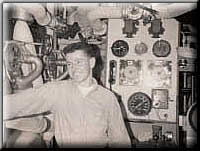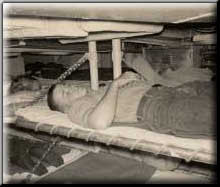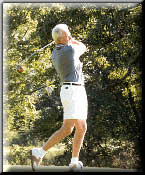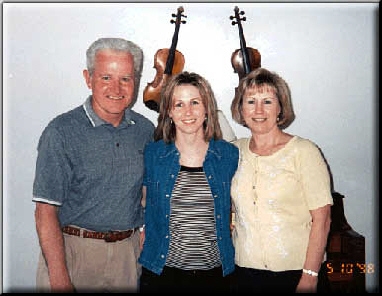"Five Years From Now, I Will Still Be Here!"
Paul Coyle, 57 year-old devoted husband, father and golfer, was diagnosed with pleural mesothelioma on February 18, 2000. The owner of a successful major appliance distributorship, Paul and his wife Carolyn make their home in St. Charles, Missouri, a suburb of St. Louis.
Paul stands 5"11" tall, and currently weighs about 158 pounds. He has lost 20 pounds since December 19, 1999. He had enjoyed excellent health until that day, when he came home from the Rams-Giants game feeling very fatigued and short of breath. It was the height of the flu season, and he assumed he was getting the flu.
Flu? Pneumonia?
He consulted with his internist in St. Charles, Dr. Knapik, who diagnosed him with the flu, and prescribed one of the new antibiotics. However, his fatigue and shortness of breath continued. Before he fell ill, he normally worked twelve-hour work days. He knew that something was wrong, and kept calling Dr. Knapik with his concerns. Finally, he requested a chest film, which was taken approximately two weeks after he fell sick. The film showed "some pneumonia" on the right side. Dr. Knapik referred him to a pulmonologist, Dr. Anthony Masi, in St. Charles. He was admitted to St. Joseph's Hospital around February 1, 2000. On the same day, Dr. Masi performed a thoracentesis via the back with a catheter, removing one and one-half quarts of yellowish fluid. The cytology was non-diagnostic, although mesothelial cells were present in the fluid.
Paul was released from St. Joseph's after being admitted for three days. The working diagnosis was pneumonia. The thoracentesis had initially relieved some of his discomfort, but his condition worsened before the end of the week. A repeat chest film was ordered for the following week. On February 11, 2000, Paul returned as an outpatient to St. Joseph's for a repeat thoracentesis. Dr. Masi drained less fluid this time, and also obtained a small sample of biopsy tissue which was insufficient for diagnostic purposes.
Talc Pleurodesis to Relieve Symptoms
Paul was then scheduled for exploratory surgery on February 17, 2000. The thoracic surgeon, Dr. Thomas Schneider, Sr., explained beforehand that he was "just going to clean [Paul] out", and that he probably would not have to insufflate talc. Dr. Schneider made one incision near the top of the back for a thoracoscopy. He also made an incision on the right beneath the armpit. He harvested biopsy tissue for pathological analysis. Frozen section analysis rendered intraoperatively gave the diagnosis of mesothelioma. Dr. Schneider performed a palliative talc pleurodesis.
Paul's doctors told him that the cell type of his mesothelioma was spindle cell, or sarcomatous mesothelioma. (Sarcomatous mesothelioma is known as the "more aggressive" type of mesothelioma, as this tumor characteristically grows faster than epithelioid mesothelioma.) The doctors also told Paul that his disease was untreatable, but referred him to Dr. Joel Cooper at Washington University in St. Louis. Dr. Cooper is a renowned lung cancer surgeon.
The Coyles Contact Dr. Harvey Pass
While the Coyles awaited their appointment with Dr. Cooper, they prudently decided to line up a third opinion, with Dr. Harvey Pass of the Karmanos Cancer Institute in Detroit, Michigan. Within 24 hours of providing Dr. Pass with their medical history and the pathology report, Dr. Pass telephoned the Coyles personally, offering to help. They scheduled a meeting with Dr. Pass for Tuesday, March 7 at Karmanos. The Coyles were very impressed with the fact that this renowned specialist had taken the time to call them personally, and so quickly, too, but their preference was for treatment locally, if this could be done competently.

Dr. Cooper: "Your tumor is inoperable"
The Coyles met with Dr. Cooper the preceding Thursday. Dr. Cooper ordered a bone scan, PET scan, an MRI, and other tests. However, he was not optimistic that he could offer Paul any treatment. He felt Paul's tumor was inoperable.
The Coyles were devastated. So far, every doctor had said that there was nothing that could be done. All of their hopes for medical treatment now resided with Dr. Pass. Devout Catholics, the Coyles took communion in their home from a visiting priest. Carolyn's eyes filled with tears as she took the Host, felt the Holy Spirit, and prayed for a miracle.
Dr. Pass' Bedside Manner and Breadth of Knowledge Impressive
Carolyn and Paul met with Dr. Pass on March 7. The Coyles liked Dr. Pass' bedside manner. He conveyed enthusiasm and hope for the treatment path which he envisioned as encompassing an extra-pleural pneumonectomy (EPP) followed by chemotherapy with Gemcytabine and Cisplatin. (Dr. Pass felt the tumor had invaded the lung itself, and thus he would have to remove the lung.). Dr. Pass helped the Coyles understand that anatomy and biology of the tumor. He drew pictures of the tumor and the surrounding tissues. He also diagramed his operative plan with a magic marker on the examining table's sanitary paper sheet. At the same time, the Coyles felt Dr. Pass was very straightforward in explaining that the treatment would likely only extend life, perhaps eighteen months' time, as opposed to seven without treatment. The goal, Dr. Pass emphasized, was to keep buying time until a more effective treatment, perhaps a cure, could be discovered.
Paul's surgery with Dr. Pass is scheduled for March 21. Paul is optimistic. As he told me, "I am going to be one of your success stories! Five years from now, I will still be here!"
Asbestos Exposure History
Paul was exposed to asbestos as a boiler tender onboard the Navy Destroyer the U.S.S. Arnold J. Isbell, DD-869 from around December 2, 1960 to August, 1963. Paul relates how he chose the job of boiler tender. His parents were poor, and their neighbors were boiler tenders for the local electric company. The neighbors advised him to work as a boiler tender in the Navy, and when he was done with his service, they would get him a job at the electric cooperative. When Paul took the preliminary aptitude tests with the Navy, he tested for a higher, better job, and the Navy tried to talk him out of doing the work, but Paul persisted, much to his later regret. Paul says that the work was dirty, and hot.

Paul boarded the Isbell in San Diego, California, and worked in the boiler room. At night, he slept six inches under insulated pipes. He participated in the Fleet Revitalization and Modernization (FRAM) overhaul of the Isbell at Bremerton, Washington, which lasted a year. He recalls the overhaul starting around June, 1961. During the overhaul, he slept onboard the ship. He recalls the presence of insulators, boilermakers, pipefitters and other civilian craftsmen while the ship was drydocked in Bremerton. He worked eight hours per day below deck plus two four- hour watches daily. There were literally miles of pipe on the Isbell. One of Paul's shipmates was another mesotheliotic and Roger Worthington client, now deceased, Machinist Mate II Mark Stewart . During the overhaul, both men were exposed daily to poisonous clouds of asbestos dust.
Mr. Coyle: "They put profit over human life."
At his deposition, one of the asbestos companies' attorneys asked Paul a series of questions about what an important safety function asbestos played in the Navy. Yes, without block and pipecovering, the boilers and pipes could cause very severe burns. Yes, without gaskets, the seal between pipe flanges might crack and dangerous hot steam hiss out. To Paul, whatever benefits the products might have had would not negate the asbestos manufacturers' duty to warn about the health dangers of their products. When finally given an opportunity to comment on what the asbestos companies knew, Paul's voice grew uncharacteristically sharp: "I have been reading about what they knew, and when. Very simply, they put profit over human life."

Paul and Carolyn were high school sweethearts. They were married on August 29, 1964, just a short while after Paul's return from the Navy. The Coyles describe their marriage and their relationship to their daughter Christine as very close. The Coyles were saddened but very proud when Christine struck out on her own to work in finance in Chicago, Illinois. Before Paul fell ill, Christine would fly home to Missouri from Chicago about once a month. Now, she flies home more often, to be with her parents when they need her love the most.
On the Cusp of Retirement
Paul is a passionate golfer. The Coyles' home looks out onto the fairway of a golf course. The practice range is a short walk away, and he visited the range daily to sharpen his skills. He played three rounds of golf in one day with his nephew. He has a hole-in-one (with witnesses!). Recently, knowing how much Paul missed golf, his golfing buddies had him ride with them and putt the balls on the greens. Carolyn used to ride in a cart with Paul on occasion. They loved to travel together. The Coyles were on the cusp of retirement, and enjoying each other's time even more. Now, all hangs in the balance with the surgery scheduled Tuesday, and the treatment to follow.
I have not heard Paul complain once about his misfortune in being afflicted with this horrible disease. He brings his faith and optimism to the trials he knows await.
Paul Coyle has the Right Stuff. Our prayers for a speedy recovery go with him.
*** POSTED MARCH 20, 2000 ***
Mr. Paul Colye passed away on May 13, 2000

